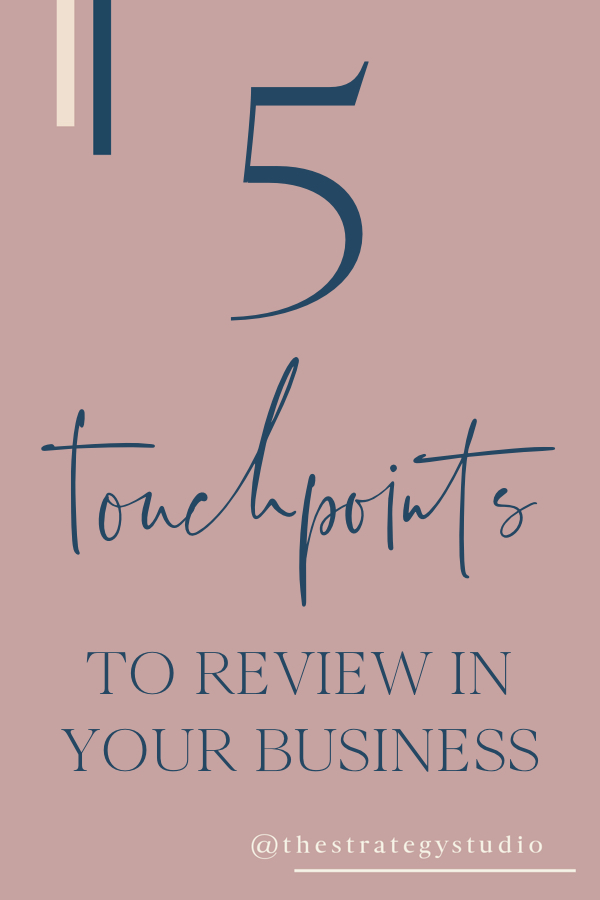5 Touchpoints To Review Today

Feel like you’re missing the mark when it comes to attracting (and booking) your ideal client? A lot of people think there’s something wrong with their product or service when their ideal client doesn’t book, simply browses or doesn’t spend as much money as you’d hoped… or doesn’t approach you in the first place. But what if I told you the solution was easier than you expect?
Let’s talk about TOUCHPOINTS.
A touchpoint is any encounter a customer has with your brand from start to finish. So that means from when they first discover you, to the end of your business transaction.
Any time one of your touchpoints is confusing, or doesn’t meet expectations, the value of your brand drops in the eyes of the consumer.
If you review your touch points from the perspective of the potential customer, you may well find your client experience is not quite as you had intended.
So here are 5 Important Touchpoints to Review in Your Business
-
Social Media and Marketing
If a potential client or customer finds you via social media, what do they see? What impressions do they gain of your business from this interaction? Are they able to make a connection with your brand, or is it a cold, impersonal experience? If they then come across paid advertising from your business, does this advertising portray that same identity as you’re projecting via your social channels? Remember, customers can spot a sales pitch a mile away so all marketing, whether paid or not, should be a strong and honest representation of your brand.
-
Website + Online Store
So a customer has found themselves on your website. Perhaps they’ve landed there via an Instagram or Pinterest link, or maybe it was a Google search. However they’ve navigated there, you now have 15 seconds to impress them! That’s the average time it takes us to decide whether or not we want to dig a little deeper on a website, or leave. In order to get your web visitors to stay longer (which will drastically increase your chance of converting them into a loyal follower or customer), take a look at the following:
-
Is your website easy to read and navigate?
-
Is your website visually pleasing and does it make an impression?
-
Is your content updated regularly?
-
Is your website genuine, or does it feel like one endless sales pitch?
-
Have you overwhelmed or confused them with too many options? (Less is more. If you try and divert your customer’s attention in multiple directions they will jump ship quick!)
-
Transactional AND Marketing Emails
Depending on your type of business you’ll have a range of different emails that your customers might receive. These could include auto-replies as a result of making an inquiry or purchase, marketing emails if people have subscribed to your email list, or personalised emails for direct interaction. Regardless of the type of email being sent, they are all a reflection of your brand. There’s no use putting all of your effort into your personalised emails if the initial “auto response” a customer experiences feels generic and impersonal. From the imagery to the language, every email matters so treat them equally!
-
Customer Service
How quickly do you respond to an inquiry? How do you handle problems with a customer’s order? Do you personalise the interaction, or does your customer service department come across as a “robot”? Whether it’s before, during, or after a customer’s transaction/interaction, your customer service matters. It will often be the experience that results in a testimonial / rating / review being given online about your business. Don’t be afraid to be human! Give the same level of care and attention to your customers as you’d expect in return from your favourite brands and businesses.
-
Testimonials, Ratings, Reviews
Which brings us to testimonials, ratings and reviews! This is a touch point that people might experience before they’ve even engaged with your brand personally. Think how much weight you give to a review when you find one online… Although no one wants to have an unfavourable review written about them, how you handle them in the public sphere speaks volumes for your brand. Customers are always appreciative of a brand and business that can handle criticism, acknowledge room for improvement and most importantly, take the time to respond. Same goes for positive reviews! Show your appreciation for people going out of their way to praise your efforts.
So there you have it! A few customer touchpoints you can start to pay attention to today. Your touchpoints will vary a lot depending on your type of business. To identify your customer touchpoints, make a list of all of the places and times your customers might come into contact with your brand and take it from there.